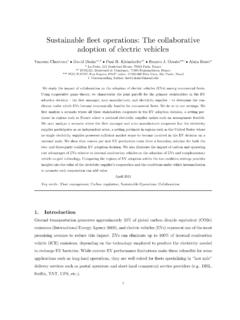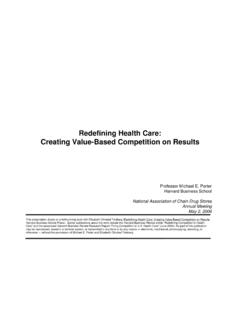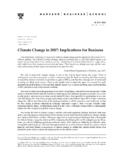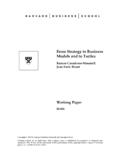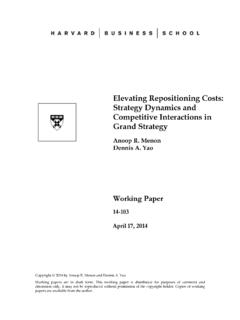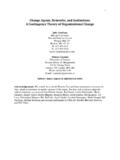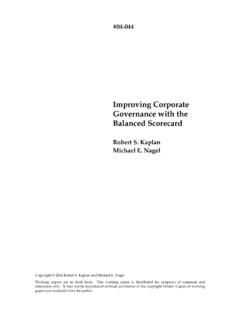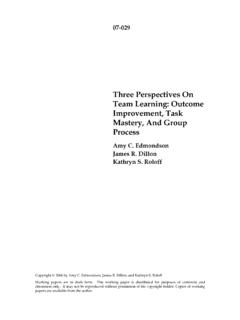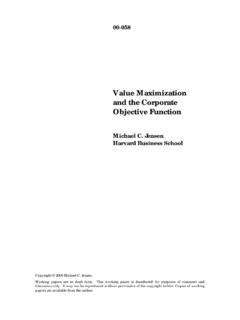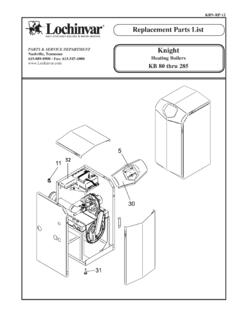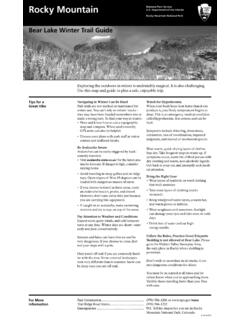Transcription of Business Model Evaluation: Quantifying Walmart’s Sources ...
1 Copyright 2012 by Humberto Brea-Sol s, Ramon Casadesus-Masanell, and Emili Grifell-Tatj Working papers are in draft form. This working paper is distributed for purposes of comment and discussion only. It may not be reproduced without permission of the copyright holder. Copies of working papers are available from the author. Business Model Evaluation: Quantifying Walmart s Sources of Advantage Humberto Brea-Sol s Ramon Casadesus-Masanell Emili Grifell-Tatj Working Paper 13-039 November 6, 2012 Business Model Evaluation: Quantifying Walmart s Sources of Advantage* November 6, 2012 Humberto Brea-Sol s Ramon Casadesus-Masanell Emili Grifell-Tatj A B S T R A C T In recent years, the concept of the Business Model has received substantial attention in the strategy literature, where a number of qualitative approaches to describe, represent, and evaluate Business models have been proposed.
2 We contend that while helpful to understand a firm s overall logic of value creation and capture, qualitative methods must be complemented with quantitative analyses. The development of quantitative methods for the study of Business models, however, has trailed that of their qualitative peers. In this paper, we develop an analytical framework based on the theory of index numbers and production theory to provide quantitative insight on the link between a firm s Business Model choices and their ultimate profit consequences. We apply the method to Walmart. Using evidence from annual reports, research papers, case studies, and books for the period of 1972-2008, we build a qualitative representation of Walmart s Business Model .
3 We then map that representation to an analytical Model that quantifies Walmart s Sources of competitive advantage over a 36-year period. Although Walmart s Business Model remained the same during the years of our study, we find that the different CEOs pulled a number of Business Model levers differently, which partly explains the variation in Walmart s performance throughout the years. Under Sam Walton, the company s performance improved due mainly to the adoption of new technologies as well as low prices obtained from vendors. David Glass s tenure was characterized by Business Model choices aimed at increasing volume such as building new stores, increasing product variety, everyday low prices (EDLP), and high-powered incentives for store managers.
4 Input and output prices played a smaller role under David Glass than under Sam Walton. Finally, Lee Scott loosened EDLP and modified Walmart s human resource practices by offering better benefits and wages to associates in response to growing social pressure. Overall, our analysis suggests that the effectiveness of a particular Business Model depends not only on its design (its levers and how they relate to one another) but, most importantly, on its implementation (how the Business Model levers are pulled). * For helpful comments, we thank Lovell from the University of Queensland (Australia) and seminar participants at the XI European Workshop of Efficiency and Productivity Analysis in Pisa and the III DEMO June Workshop, Economics of Organizations, Corporate Governance and Competitiveness, Barcelona.
5 Brea-Sol s thanks l Ag ncia de Gesti d Ajuts Universitaris i de Recerca de la Generalitat de Catalunya for financial support. Casadesus-Masanell thanks the HBS Division of Research. Grifell-Tatj thanks the Spanish Ministry of Science and Technology (ECO2010-21242-C03-01) and the Generalitat de Catalunya (2009 SGR 1001) for financial support. HEC Management School, ULg. Harvard Business School. Business Department, Universitat Aut noma de Barcelona. 1 1. Introduction In recent years the strategy field has become increasingly interested in the study of Business Although the expression was introduced long ago by Peter Drucker,2 academic work on Business models began just a decade ago in the context of the Internet boom, where entrepreneurs were asked to explain how their ventures would create value (the wedge between customer willingness to pay and supplier willingness to sell, see Brandenburger and Stuart, 1996) and how value would be captured as profit.
6 Indeed, the most common definition of Business Model is the logic of the firm, the way it operates, and how it creates and captures value for its stakeholders. 3 Casadesus-Masanell and Ricart (2008, 2010, 2011) and Casadesus-Masanell and Zhu (2010) operationalize this notion by decomposing Business models into two fundamental elements: choices such as policies, assets, and governance of policies and assets and the consequences of these choices. The causal links between choices and consequences help explain the logic of the firm, how it creates and captures value for its stakeholders. These authors also propose a methodology to represent Business models qualitatively.
7 While Business Model representations help improve an analyst s understanding of a firm s value logic, the methodology proposed offers little guidance on how the causal links between choices and consequences can be quantified. Without quantification, a detailed study of a firm s Business Model is incomplete because there is often too much freedom on how to interpret relationships between firm choices (such as low prices, heavy investment in technology, or high-powered incentives for managers) and their consequences (such as volume, bargaining power with suppliers, or a culture of frugality). In this paper we propose a novel approach to quantify the link between a firm s choices and their consequences and, ultimately, for gaining a better understanding of the virtues and weaknesses of a firm s Business Model .
8 The method builds on recent advances in production theory and index numbers by Grifell-Tatj and Lovell (1999, 2008, 2012) and relates Business Model choices to profit variations over time. Its starting point is the observation that profits raise and fall for two reasons: changes in either prices or quantities. In particular, a firm s profits could increase for any of the following reasons: (a) selling goods at higher prices; (b) paying less for inputs, such as labor or capital; (c) selling more goods while holding constant 2 their cost markup; or (d) using fewer inputs per unit of good produced/sold. Note that (a) and (b) are related to prices whereas (c) and (d) are related to quantities.
9 Our method quantifies how much of a firm s profit variation is due to price and how much is due to quantity effects. These two effects, in turn, are determined through Business Model choices. [INSERT FIGURE 1 ABOUT HERE] Indeed, the key to our approach is the realization that, at heart, Business models create and capture value by acting on prices and volumes. For instance, Ryanair a company that competes through a generic low-cost strategy has made Business Model choices, such as flying to secondary airports or the use of a standardized fleet of 737s, that have led to lower input prices. Likewise, Ryanair has chosen to maximize the number of seats in its aircraft by offering coach service only and removing the kitchenette, which has led to larger volumes.
10 Thus, a quantification Ryanair s profit variation over time due to prices and to volumes shall provide valuable information on how the firm s Business Model works. As noted, the analytical framework that we propose combines the theory of index numbers and production theory, uses publicly available information about realized prices and volumes, and has two levels of The first level uses index numbers to produce an aggregated estimate of the price and quantity In particular, we build Bennet-type indicators for prices and quantities of inputs ( , labor and capital) and outputs ( , final products).6 The price effect obtained through index numbers is useful to quantify, for example, the impact of Business Model policies that affect prices of inputs and outputs ( , product range or new supply Sources ) on profits.
